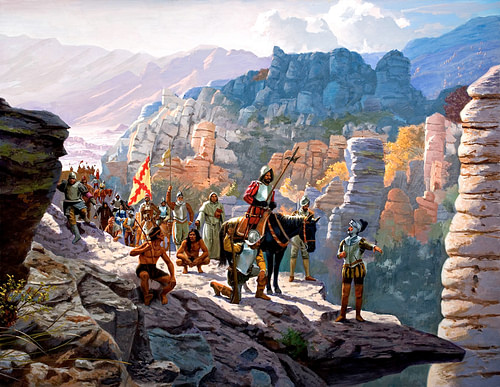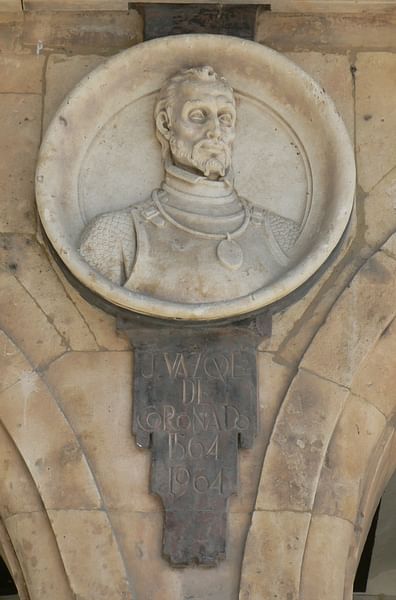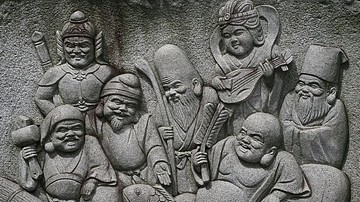The Seven Cities of Cibola are the mythical lands of gold that the Spanish of the 16th century believed existed somewhere in the southwest of North America, comparable to the better-known mythical city of El Dorado. No sites matching the descriptions of the European explorers who first reported them were found but these launched an expedition which destroyed many others.
The cities were first attested to by four survivors of the disastrous Narvaez Expedition of 1527, including the explorer Álvar Núñez Cabeza de Vaca (d. c. 1560), in 1536. De Vaca’s report was later “corroborated” by the Franciscan friar Marcos de Niza (l. c. 1495-1558) in 1539. De Niza’s colorful description of the wealthy site encouraged the 1540 expedition into North America by conquistador Francisco Vázquez de Coronado (l. 1510-1554) who found no such cities.
The Coronado expedition did manage to kill a large number of Native Americans, however, either directly or by robbing their food supplies so they starved. Setting out from Compostela in northwest Mexico, Coronado traveled to modern-day New Mexico where he found the tales of the golden city to be a fable. After taking the city, he then destroyed other communities before being convinced of the existence of an even grander city of gold, Quivira, and his quest to find this mythical place took him as far north as modern-day Kansas. The natives he had abused after taking Cibola were later found to have invented Quivira as a means to send him off into the wilderness where he and his men would weaken and die.
The expedition bankrupted Coronado, who had been so certain of the reports of de Niza that he had funded it himself. Although Coronado is often praised as the first European to explore the southwest, his immediate effect on the region was negative, his legacy negligible, and the expedition’s only real significance is in the report by Garcia López de Cárdenas (l. c. 1540s), one of Coronado’s officers, and others which provide a first-hand account of the lives of the native peoples they encountered and natural formations such as the Grand Canyon. The persistent boast by historians that Coronado’s expedition was the first to see such sites and record such things increasingly rings hollow, however, as more people in the modern era have come to recognize the shallow motivation of the expedition and the destruction it wrought on Native American communities.
Narvaez Expedition & De Vaca
The story of the Seven Cities of Cibola begins with an expedition that had nothing to do with it. In 1527, the conquistador Pánfilo de Narváez (d. 1528) was sent from Spain with 600 men, a certain number of women and slaves, and five ships to colonize Florida, which had been claimed for the Spanish Crown by Ponce de León (l. 1474-1521) in 1513. They were shipwrecked off Cuba in a storm that drove the roughly 400 survivors onto the shores of the west coast of Florida, near modern-day Tampa Bay.
Narváez had no idea where he was and divided his party in two, with over 100 to travel by ship and the remainder by land to head north where he expected to find a harbor. Although Ponce de León had claimed the land, he was unable to establish a fort or leave any kind of directional, so Narváez can hardly be blamed for becoming disoriented. The ship and the land party lost sight of each other and those on land continued to march until they wound up in the region of modern-day Texas. Once no harbor was found nor any landmarks mentioned in de León’s report, Narváez made the decision to have rafts built, which would be used to navigate the coast and find where they should have landed. A storm drowned most of the 300 aboard the rafts, including Narváez, and the survivors, thrown back onto the Florida coast, died in the following months until there were only four:
- Álvar Núñez Cabeza de Vaca
- Alonso del Castillo Maldonado (d. 1547)
- Andrés Dorantes de Carranza (d. 1550s)
- Estevanico (l. c. 1500-1539)
Estevanico was a Moor, enslaved since c. 1522, who was owned by de Carranza. The four men walked across Texas, were captured by natives who enslaved them for four years, escaped, and fled into the interior. Over the next few years, the men lived among the natives, traveling from place to place, acquired a reputation as healers, and finally made it back to Mexico City in 1536 where the stories of their adventures – and especially of the vast wealth of the lands they had traveled through and glistening cities of gold – attracted significant attention.
De Niza Expedition
Word of the riches to the north finally reached the viceroy of New Spain, Antonio de Mendoza (l. 1495-1552), who then ordered a scouting party organized to be led by the friar Marcos de Niza in 1539. The problem was, however, that no one knew where these cities of gold were. De Vaca, the main source of these stories, had sailed back to Spain in 1537, and even if he had not (as his later published work on his adventures shows), he would not have been very much help since he called the people he met and places he visited by his own names depending on what they ate, how they dressed, what a certain rock formation reminded him of. Estevanico was still in the area, however, with his master, and de Niza chose him as the guide.
Estevanico was most likely only too happy to return to the north and live as a free man again and so the small party set out. As they traveled, they attracted native traders who encouraged de Niza with stories of the great cities of gold they were sure to arrive at soon. Estevanico was sent ahead of the main group to locate the cities and send word back and, after some unknown number of days or weeks, a native scout brought word that Estevanico had found Cibola and was waiting there. Scholar Bill Yenne relates Estevanico’s description to de Niza:
There were "Seven very large cities which were all subject to one lord. In them were large houses of stone and mortar, the smallest of which were one storey high with a terrace, and there were besides two- and three-storied buildings. The chief’s house was of four stories. There were many decorations at the entrance of the principal houses, and turquoises, which were very plentiful in the country. The people of these cities were very well clothed". (125)
De Niza hurried to catch up with Estevanico but then received word he had been killed. No one knows how he died (there is also the claim that he was not killed but only faked his death to win his freedom), but de Niza was told that he had tried to impersonate a medicine man and had demanded valuables and women from the people of the city; so they killed him. De Niza was afraid to go any further and so climbed a mesa and, "without actually setting foot in one, took one last, lingering look at the pueblos…and quickly retreated to Mexico" (Yenne, 126). Once there, he entertained Mendoza and others with tales of the fabulous cities he had seen. Yenne comments:
He let his imagination run rampant, reporting things that he could not have seen without entering one of the seven cities. He wrote of huge pearls and emeralds [and] he said that the people ate off of gold and silver plates…He also claimed that the Seven Cities of Cibola were equal in population to Mexico City. (127)
The impression given was of a vast and wealthy urban center, and although de Niza could not possibly have known it, he was actually correct. The cities he had seen were part of the Zuni-Cibola Complex of modern-day New Mexico which at that time was the largest trade center in the region. Scholar James J. Drexler notes:
[Cibola] was a center of trade over a vast and active trading network that covered most of northern Mexico and much of the western United States. Cibola trading extended eastward to the Great Plains region where they obtained bison hides and westward to at least the lower Colorado River…The trade network extended to the west coast of Mexico where the natives of Cibola obtained seashells and southward into present-day Mexico where they obtained various brightly feathered birds. The Cibolans were aware of the Mississippi River, the Gulf coast of Texas and Mexico, the west coast of California, the Grand Canyon of the Colorado River and the rivers and plains of Oklahoma and Kansas. There were civilized people with an ancient culture and tradition. (103)
Mendoza was not so much interested in what de Niza had to say about the people living at Cibola except in so far as they sounded like they would be able to pay enormous amounts of tribute once they were conquered; and so he organized a second, and much larger, expedition to accomplish that.
Coronado Expedition
Coronado was the governor of New Galicia (modern-day Sinaloa and surrounding areas in Mexico) in New Spain at this time and married to a woman from a wealthy family. He was backed by her family and secure in his position when he heard de Niza’s story of Cibola and volunteered his services to Mendoza to lead the expedition. He was so confident of success and the riches he would return with, he said, that he would even finance the entire venture himself. Mendoza put up some of the money required so he would have a further stake in the spoils. No one doubted de Niza’s report was accurate and, in fact, as the story of the friar’s adventure to the fabulous city was retold, the buildings became larger and the wealth even grander. Coronado took de Niza as his faithful guide and set out with three hundred soldiers, over a thousand native auxiliaries, an enormous supply train, cattle for beef, and herds of extra horses, almost all of this paid for by himself, in February of 1540.
In early July they reached the place where de Niza said Estevanico had been killed; it looked nothing like the fabulous cities he had described back in New Spain. Coronado’s officer and chronicler, Castaneda writes:
It is a little, crowded village, looking as if it had been crumpled all up together. There are haciendas in New Spain which make a better appearance at a distance. It is a village of about two hundred warriors, is three and four stories high, with the houses small and having only a few rooms, and without a courtyard. (136)
Coronado marched on the city, demanding its surrender, and when the people refused, he attacked. According to Castaneda’s account, it was not an easy battle, and Coronado himself was wounded. The Spanish were able to defeat the Cibolans, however, due to their use of cavalry and superior firepower which awed the natives and finally led to them abandoning the city. When Coronado marched in expecting to find heaps of gold and jewels, however, he found nothing but broken ceramic pots, dead bodies, and empty homes.

Castaneda reports that Coronado and the others immediately turned on de Niza and were so angry that Castaneda worried for the friar’s safety, writing, "such were the curses that some hurled at Friar Marcos that I pray God may protect him from them" (136). Coronado inspected the city thoroughly and then wrote a report to Mendoza that the friar’s account had been false; he sent de Niza along with the departing troops to deliver it. Castaneda, in describing the friar’s departure, apparently forgets about his earlier fears for de Niza’s safety and more or less calls him a liar:
[De Niza went back] because he did not think it was safe for him to stay in Cibola, seeing that his report had turned out to be entirely false, because the kingdoms that he had told about had not been found, nor the populous cities, nor the wealth of gold, nor the precious stones which he had reported, nor the fine clothes, nor other things that had been proclaimed from the pulpits. (136-137)
Coronado then sent his officers to explore the region while he completed the task of appropriating Zuni homes and food supplies. Word was sent out to the other native communities that "Christians had come into the country, whose only desire was to be their friends" and all were welcome to come and talk with Coronado, but unsurprisingly, there was not a great response to this offer (Yenne, 138). Coronado’s officers, however, were initially greeted with song, dance, and gifts when they arrived at different communities, and the people welcomed them until they found the new arrivals could not be trusted.
At the Tiguex pueblos (near modern-day Santa Fe, New Mexico) Coronado met a native from the Mississippi region who was being kept as a slave who is known from Castaneda’s reports as "the Turk". The Turk told Coronado of a fabulous land of riches to the north known as Quivira and offered to lead him there. The party set out in April or May of 1541 and after well over a month had found nothing suggesting a city of gold, although the Turk continually assured them it was just a little further ahead. Along the way, the expedition murdered 200 natives in one village by burning some at the stake and trampling others under their horses, murdered more elsewhere, raped native women, stole food supplies and left the people to starve, and destroyed native homes and villages as a means of establishing order, civilization, and Christian values.
After all of this, Coronado still found himself no closer to the golden city of Quivira. Finally, somewhere near modern-day Salina, Kansas, Coronado’s patience ran out, and he confronted the Turk who admitted he had lied and there was no such place. The Turk told Coronado he had only wanted to be free and hoped to make his way back to his people by leading the Spanish on this quest but, also, he had been told to purposefully mislead Coronado by the natives around Cibola who had hoped he would become lost and die in the wilderness.
Coronado listened to his explanation and then had him strangled. Afterwards, he announced they would be returning to New Spain since, in the words of one of his officers, "the party never found a land in which it would be possible to settle" and the Seven Cities of Cibola had turned out to lack "wealth and civilization" (Flint, 2). Coronado arrived back in New Spain in the spring of 1542 and resumed his position as governor of New Galicia, but he was disgraced and bankrupt. De Niza was also publicly scorned but was never punished and lived out the rest of his life in obscurity.
Conclusion
The quest for the Seven Cities of Cibola was only one of over 130 expeditions launched by the Spanish in the Americas in search of gold during this period. At the same time Coronado was ravaging the southwest, Hernando de Soto (l. c. 1500-1542) was raping, murdering, and burning the villages of the natives of the Mississippi River Valley on his quest for the gold he was sure they had hidden. Gonzalo Pizarro (l. 1510-1548), the younger brother of Francisco Pizzaro (conqueror of the Incas) was also active in 1541, destroying and enslaving native communities in Ecuador in his search for the golden city of El Dorado.
These expeditions have been praised for centuries as "firsts" as though the landscape and the people had no inherent value until they were "discovered" by Europeans who are always characterized as explorers rather than as slavers or simply greedy opportunists who took advantage of populations that initially welcomed, trusted, and helped them. Coronado’s expedition to Cibola is nothing to celebrate, any more than any of the others are.
The Cibola expedition was a ludicrous project based on lies and driven by avarice which accomplished little beyond the loss of lives in communities which had existed on the lands Coronado rode through for thousands of years. None of those people, nor their descendants, could have cared less that these Spanish were the first to record their land and culture in history.
Continual praise of expeditions like Coronado’s is comparable to admiration heaped on a bank robber who, after killing everyone in the building, stumbles upon a rare coin; history texts regularly focus on the coin while largely ignoring the cost of its discovery. The Seven Cities of Cibola never existed any more than El Dorado or Quivira but the quest to find these imaginary places resulted in the destruction of very real ones, and that is the real story of Cibola.







